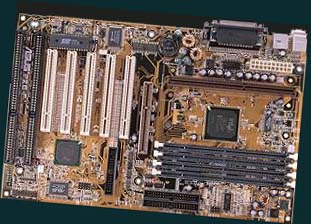Hardware
Audio
Controllers
General
Mainboards
Memory
Modems
Monitors
Portables
Printers
Processors
Scanners
Storage
Video
Games
Reviews
Previews
Cheats
& Hints
News
General Info
About
Us
Advertising
Awards
Contact
Us
Hot
Links
|
ASUS P2B-F Manufacturer
ASUStek
Expansion
Slot : 5/2/1
There’s
something with motherboard manufacturers and the letter A. Having got past
Abit and AOpen, we come up with ASUS, whose biggest hit to date has surely
been their P2B series. We’ve got two members of the P2B family in this
roundup, and the first is the P2B-F, the tenth revision to the P2B line.
ASUS has basically fine-tuned the original P2B- dropping one ISA slot in
favor of a new PCI slot and the addition of an extra DIMM slot are two
of the most noticeable changes. So the P2B-F now has a configuration of
5 PCI/2 ISA/1 AGP and 4 DIMM slots, which is just about the ideal configuration
at the moment- enough PCI slots to go around as well as enough ISA slots
to ensure backward-compatibility, plus the extra DIMM to take you all the
way up to 1GB of RAM. But the best thing about the P2B-F is probably the
introduction of new FSB speeds- 110, 115, 124, 140 and all the way up to
a whopping 150 (yikes!). The board is fitted with ten capacitors to improve
stability.
I have to point out here that the collapsible CPU holder isn’t that good- it’s just not providing enough support to SECC-2 Celeron CPUs. Like
the original P2B, ASUS have stolidly resisted the advent of the jumperless
era with the P2B-F. If you were feeling nostalgic for jumpers (in the wake
of the sudden boom in all varieties and variations on the theme of jumperless
setups that have popped up recently) by all means take a good look at the
P2B-F. Jumpers galore- you’ll never feel lonely again. ASUS provides an
extensive and well-written manual detailing jumper configurations et al,
so don’t worry about the lack of a jumperless setup (talk about double
negatives…the lack of a jumperless setup?). And don’t get the impression
that the ASUS P2B-F is not an overclocker’s board because there are jumpers
on it (err…people were overclocking ages before jumperless setups, by messing
with–what else?- jumpers), because such an impression would be totally
erroneous. In fact, if you did receive such an impression, dear me, I urge
you to lose it fast. Not only is the ASUS P2B-F not not an overclocker’s
board (all right, so I contrived that sentence deliberately…overclocking
the English language here, that’s what we’re doing), it may well be the
board most suited to overclocking ever built. Whether you’re talking stability
or speed, the ASUS P2B-F rates up there at the very top, with the only
possible competition being from the Abit BX6 2.0. You know how we (and
most other reviewers as well) take pains to point out to you all the time
that performance differences between BX boards are usually negligible?
Well, the performance differences between the BX6 2.0 and the P2B-F would
probably give the word “negligible” a whole new meaning, so why don’t we
quit talking about it and get back to the point, which is the P2B-F and
the story of its life. A word or two here about hardware monitoring; you
need to buy the thermistor separately and fix it to the board to get CPU
temperature monitoring and the works. Otherwise, the board will only give
you system temperature figures.
Next up, we have a very close cousin of the P2B-F in the hot seat. Does the word SCSI set your pulse pounding and send adrenalin surging through your system? (Well, whether it does or not, read on…) |
|
|
|
|

